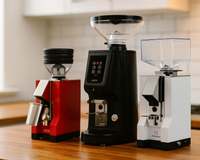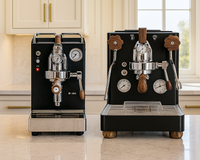Espresso Machine Warm-Up Time: Why It Matters & How to Speed It Up
If you’ve ever pulled a shot of espresso right after turning on your machine, only to be disappointed by the taste, you’re not alone. One of the most overlooked aspects of brewing high-quality espresso at home is warm-up time.
Whether you’re using a single boiler, heat exchanger, or dual boiler machine, understanding and optimizing warm-up time can make the difference between average and café-quality espresso. In this guide, we’ll explain why warm-up time matters, how different machines compare, and what you can do to speed up the process.
Why Warm-Up Time Is So Important

Espresso machines require thermal stability to produce consistent results. It's not just the water that needs to reach temperature—the group head, boiler(s), internal piping, and even the portafilter must all stabilize for optimal extraction. Brewing too early leads to:
- Inconsistent shot temperatures
- Under-extracted, sour espresso
- Weak or unstable crema
This is especially important with machines featuring the E61 group head, which is large, brass, and takes a while to heat up fully—sometimes up to 30–45 minutes.
Typical Warm-Up Times by Machine Type
| Machine Type | Typical Warm-Up Time |
|---|---|
| Single Boiler (e.g. Lelit Anna) | 5–15 minutes |
| Heat Exchanger (e.g. Mara X, Rocket Appartamento) | 20–30 minutes |
| Dual Boiler (e.g. Lelit Bianca V3, Profitec Pro 700) | 25–45 minutes |
| Thermoblock (e.g. Breville Bambino) | 1–5 minutes |
Keep in mind: The group head is the last component to fully heat, and it plays a critical role in extraction temperature stability.
How to Know If Your Machine Is Fully Warmed Up

Don’t rely solely on the PID or temperature light. Use these methods:
- Touch the group head: It should feel hot—almost too hot to touch for more than a second or two.
- Use an infrared thermometer: Measure the group head or portafilter temperature (ideally around 195–205°F).
- Water temperature test: Run water through the group into a cup and measure with a thermometer.
Bonus tip: Some advanced users install thermometers or flow control accessories to monitor real-time group temperatures.
Ways to Speed Up Espresso Machine Warm-Up
1. Use a Smart Plug or Timer
Set your machine to turn on 30–45 minutes before you wake up. Smart plugs like TP-Link or Amazon Smart Plug work great with most machines.
2. Leave the Portafilter In
Always keep the portafilter locked into the group head during warm-up. This helps it heat evenly, reducing thermal shock during brewing.
3. Run Blank Shots
Running hot water through the group head can help heat internal components faster, especially if you're in a rush.
4. Insulate or Pre-Heat Your Cup
Preheating cups with hot water reduces heat loss during extraction. Consider using a cup warmer or boiler-top storage if available.
5. Upgrade to a Machine with Faster Recovery
Machines like the Lelit Mara X are engineered for faster warm-up and stable temperature, ideal for busy mornings.

Warm-Up Time & Workflow: What It Means for You
If you only make one drink per morning and don't want to wait, a thermoblock or single boiler might suit you best. If you make milk drinks or entertain guests often, investing in a machine with longer warm-up but better thermal stability (like a dual boiler) will pay off in espresso quality.
Think of warm-up time as part of your daily brewing ritual. Just like preheating an oven, taking time to get your machine ready results in dramatically better output.
Best Machines with Fast or Stable Warm-Up
Lelit Mara X

- Heat exchanger with PID control
- Warm-up time: ~20–25 minutes
- Auto temperature mode for beginners
Lelit Bianca V3

- Dual boiler with E61 group head
- Warm-up time: ~35–45 minutes
- Exceptional temperature consistency
Profitec Pro 700

- Dual boiler with rotary pump
- Warm-up time: ~30–40 minutes
- PID control and plumb-in ready
Final Thoughts
Warm-up time might seem like a minor detail, but it plays a major role in how your espresso tastes. Whether you're brewing for one or preparing drinks for guests, allowing your machine to fully warm up ensures consistent results and a better overall coffee experience.
Want help finding a machine that matches your schedule and workflow? Contact us here — we’ll help you find the perfect fit.
Explore our full lineup:
Shop All Espresso Machines →















